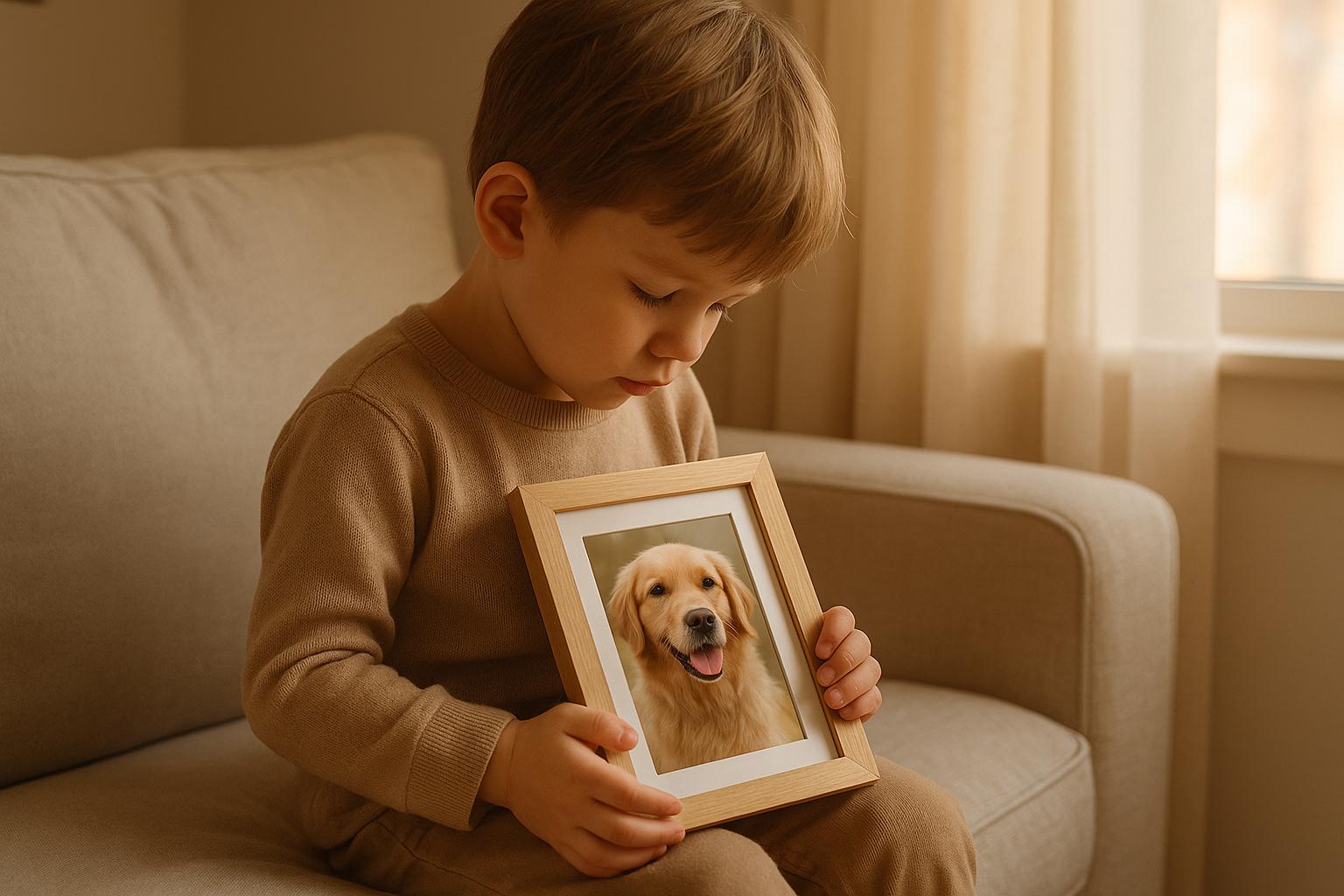Losing a pet is often a child’s first encounter with death, which can be confusing and emotionally overwhelming. How you address this sensitive topic can shape how they cope with grief in the future. Here’s a quick guide to help:
- Be Honest and Clear: Avoid euphemisms like "went to sleep." Use simple, age-appropriate language to explain death.
- Age Matters: Younger children may not understand the permanence of death, while older kids might experience grief similar to adults.
- Validate Their Feelings: Let them know it’s okay to feel sad, angry, or confused. Grief looks different for everyone.
- Encourage Questions: Answer their concerns with patience and honesty, whether about the pet’s death or their own fears about mortality.
- Memorialize the Pet: Activities like creating a photo album, writing stories, or holding a small service can help them process their emotions.
The goal isn’t to eliminate their sadness but to guide them through it in a healthy way. Every child grieves differently, so adapt your approach to their unique needs.
Talking to Children about Pet Loss | The Parmenter Foundation

How Children View Pet Death at Different Ages
Children experience the loss of a pet differently depending on their stage of development. What seems straightforward to adults can be puzzling for younger minds. Studies indicate that most children begin to fully understand the concept of death between 5 and 7 years old, though some may start grasping parts of it as early as age 3.
Understanding death involves five key ideas: that it is permanent (irreversible), universal (happens to all living beings), applicable (it could happen to anyone), involves the cessation of all bodily functions, and has a cause. These concepts develop progressively, with permanence often being the first understood and causation the last - usually by around age 8.
What Death Means to Children by Age Group
Under 2 Years:
At this stage, toddlers don't comprehend death but are highly attuned to the emotions of their caregivers. They may react to the emotional atmosphere with behaviors like increased fussiness, clinginess, or changes in eating and sleeping patterns.
Ages 2 to 5:
Preschoolers often see pets as playmates rather than deep emotional attachments. Their grief tends to focus on the absence of their companion. They may view death as temporary, imagining the pet will return, much like leaves regrow in spring. Common reactions include regression (like thumb sucking or bedwetting), nightmares, or "magical thinking", where they believe their thoughts or actions might have caused the pet’s death.
Ages 5 to 9:
Children in this age group start to understand that death is permanent, though they might still experience denial or bargaining. Guilt can surface, particularly if they’ve had negative feelings toward the pet. They might avoid talking about the loss, fearing an emotional breakdown, and changes in sleep, eating, or play habits are common.
Ages 10 and Up:
By this age, pre-teens and teens fully grasp that death is permanent and inevitable for all living things. Their grieving process often mirrors that of adults, including stages like denial, anger, guilt, and acceptance. However, their emotions may feel more intense as they navigate ongoing emotional development. They might withdraw from social interactions, show a drop in academic performance, or lose interest in hobbies. Physical symptoms like headaches or stomachaches can also arise as a response to stress. Additionally, they may express curiosity about the biological aspects of death.
These age-specific patterns highlight how children’s understanding of and response to death evolves as they grow.
How Each Child Grieves Differently
Even children of the same age can react to pet loss in vastly different ways. One 6-year-old might cry openly and want to reminisce about their pet, while another may seem indifferent and continue playing as usual. Both reactions are completely normal.
Some children process their grief through play, inventing games or stories about their pet, while others may become more reflective and curious about life and death. Temporary behavioral changes like aggression, withdrawal, or clinginess are common. Regression is also a typical response - such as a potty-trained child having accidents or a teenager seeking extra physical comfort like hugs.
It’s important to remember there’s no single "correct" way to grieve. While some children need open conversations and emotional support, others prefer quiet reassurance and sticking to familiar routines. Parents sometimes underestimate their child's ability to understand death and may avoid discussing it, assuming the child isn’t ready until around age 7 or later. This can lead to the use of vague euphemisms or a lack of communication, which might hinder the child’s ability to process their emotions.
The best approach is to tune into your child’s unique needs and communication style. If they ask questions, provide honest, age-appropriate answers. If they seem to avoid the topic, gentle support and a focus on normal routines can be more helpful than pushing for discussions. Each child’s grieving process is deeply personal, and understanding their individuality is key.
How to Talk to Children About Pet Death
Talking to children about the death of a pet can feel daunting, but it’s an important opportunity to help them understand loss and develop healthy coping skills. Clear and honest communication is key to guiding them through this emotional experience. Here’s how to approach the conversation in a way that’s meaningful and age-appropriate.
Speaking Clearly and Honestly About Death
When discussing death with children, avoid using euphemisms like "put to sleep", "went away", or "lost." While these phrases might seem gentler, they can confuse children and even lead to unnecessary fears. For example, saying a pet was "put to sleep" might make a child anxious about bedtime, and "went away" could create worries about loved ones disappearing.
Instead, use simple and direct language that matches your child’s level of understanding. For younger kids, you might say: "Max’s body stopped working, and he died. He can’t eat, breathe, or play anymore." Older children may benefit from more specific details, such as explaining the illness, old age, or accident that caused the death.
Be ready for a mix of responses. Some children may ask lots of questions immediately, while others may need time to process the information quietly. Both reactions are completely normal, so follow their lead.
How to Answer Children's Questions About Pet Death
Children often revisit the same questions as they process what’s happened. Answering patiently - even if the question is repeated - helps them work through their emotions and understanding.
- "Why did my pet die?" Offer an honest explanation that fits their age. For example: "Sometimes pets get very sick, and their bodies can’t get better, even with medicine. Other times, pets die because they’re very old, and their bodies wear out."
- "Will my pet come back?" Be clear that death is permanent. You could say: "No, Max won’t come back. When someone dies, their body stops working forever, and they can’t come back to life."
- "Did I do something wrong?" Reassure them firmly: "No, you didn’t do anything wrong. Sometimes pets get sick or hurt, and it’s not anyone’s fault. You were a wonderful friend to Max, and he loved you very much."
- "Where is my pet now?" This is a chance to share your family’s beliefs. You might say: "Some people believe pets go to a special place called heaven. Others think they become part of nature. What’s most important is that we remember Max with love in our hearts."
- "Am I going to die too?" Address this fear gently but honestly. "Yes, all living things die one day, but most people and pets live for a very long time. You’re healthy and strong, and I expect you to live for many, many years. My job is to keep you safe and healthy."
- "Can we get another pet?" Explain that while you might consider adopting another pet in the future, it’s important to take time to grieve first. Emphasize that a new pet won’t replace the one who passed away, as each pet is special and unique.
Including Your Family's Beliefs in the Conversation
Sharing your family’s beliefs - whether spiritual or secular - can provide comfort while reinforcing the reality of death.
If your family believes in a pet afterlife, you might say: "We believe Max’s spirit is in heaven now, where he’s happy and not sick anymore. His body died, but we think his spirit is in a peaceful place." This approach acknowledges both the physical reality of death and your spiritual beliefs.
For families with a secular perspective, focus on natural cycles: "Max’s body will become part of the earth, helping plants grow. The love and memories we shared with him will always be with us."
Children may also hear different beliefs from friends, relatives, or media. Encourage open discussion by saying: "Different families believe different things about what happens after death. In our family, we believe... but it’s okay that other families think differently."
Avoid making promises you can’t guarantee, like saying, "You’ll see Max again someday." Instead, focus on the love and memories you’ll always carry: "We’ll always remember the happy times we had with Max, and the love we shared will stay with us."
If your child has experienced the death of a human loved one, be consistent in how you explain death. Contradictory explanations can confuse children and make it harder for them to process their emotions.
How to Help Children Through the Grieving Process
When a child loses a pet, they need understanding, guidance, and a supportive environment to help them process their emotions. Every child experiences grief differently, and helping them through it not only eases their pain but also builds their emotional strength. Here are some effective ways to support children during this time.
Helping Children Express Their Feelings
Creating a safe and nonjudgmental space is crucial for children to work through their grief. Children may cry, withdraw, or talk about their pet - these are all normal reactions. Let them know it’s okay to feel sad, angry, or confused.
Encourage creative activities like drawing, writing, or storytelling as outlets for emotions they might struggle to put into words. Sharing your own feelings about the loss can also set an example, showing them that it’s okay to grieve openly. Alongside these emotional outlets, maintaining consistent routines can help provide a sense of security as they process their loss.
Keeping Children Feeling Safe and Supported
Sticking to regular daily routines - like consistent meal times, bedtime rituals, and school schedules - can help children feel grounded when their emotions are in turmoil. Stability in their day-to-day life can bring comfort during a time of uncertainty.
Reassurance is key, especially since grief can resurface even after some time has passed. Listen patiently and offer comfort, even if your child repeats the same questions or stories. Informing other adults in their life - teachers, babysitters, coaches, and family members - about the pet’s passing ensures your child receives understanding and care in all environments.
Let children know that it’s natural to miss their pet and that their feelings are valid. Healing doesn’t happen overnight, so avoid pushing them to “move on” too quickly. Instead, acknowledge their emotions calmly and with empathy.
When to Get Professional Help for Grieving Children
While most children navigate the loss of a pet with family support, there are times when professional help might be necessary. If grief symptoms become prolonged or unusually intense, it may be time to seek guidance.
Look out for persistent nightmares, significant behavioral changes, or disruptions in eating and sleeping patterns that last beyond two to four weeks. If these issues interfere with daily life, consulting a pediatrician or child psychologist can provide the additional support your child needs.
sbb-itb-a4e988d
Ways to Remember and Honor Your Pet
Memorial activities can provide a meaningful way to honor a pet's memory while helping children process their grief. These activities allow kids to channel their emotions into positive and creative expressions of remembrance.
Memorial Projects for Children
Photo albums and scrapbooks are a heartfelt way for children to preserve memories. They can gather photos of their pet, add drawings of special moments, and write short stories about the adventures they shared. Including personal items - like a collar, a favorite toy, or pressed flowers - can make the project even more special.
Memory boxes are perfect for younger children. A simple shoebox can be decorated and filled with treasures like a blanket carrying the pet’s scent, favorite treats, or handwritten letters. Encourage kids to write about what they loved most about their pet or what they’ll miss.
Art projects give children a creative outlet for their feelings. They might draw pictures, make clay paw prints, or create posters. Some families even choose to plant a tree or start a small garden in their pet’s honor, offering a lasting tribute.
Digital tributes appeal to older children and teens. They can create video slideshows set to music, compile photo collages, or write blog posts recounting cherished memories.
These projects naturally lead to family ceremonies, giving everyone a chance to come together and celebrate the pet’s life.
Holding Family Memorial Services
A family memorial service can provide closure and comfort. Something as simple as lighting a candle, sharing stories, or reading a poem can be deeply meaningful.
Many families choose a location that was special to their pet - like a favorite park or the backyard they loved to play in. Children can participate by sharing memories, reading letters they’ve written, or showcasing artwork they’ve created. Some families include symbolic gestures, such as releasing biodegradable balloons or scattering flower petals, to say goodbye.
Timing is important when planning a service. Some families hold it shortly after their pet’s passing, while others wait until emotions have settled. It’s often best to follow the child’s lead - some may want to honor their pet right away, while others might need more time to process their feelings before participating.
Creating a memorial tradition can bring ongoing comfort. Families might revisit a favorite hiking trail on the anniversary of their pet’s passing or make a donation to an animal shelter in their pet’s name. These annual rituals give children a meaningful way to keep their pet’s memory alive year after year.
For families looking for additional support, Animal Aftercare offers specialized services to help guide the memorial process.
Animal Aftercare's Memorial Services

Animal Aftercare provides compassionate, 24/7 nationwide support for families creating pet memorials. Their individual cremation services, with 100% assurance tagging, ensure that families receive only their pet’s ashes. They also offer home collection services, easing the burden of transportation during such an emotional time.
Once the ashes are returned, families can decide how best to honor their pet - whether by keeping them in a special place, scattering them in a meaningful location, or incorporating them into a memorial garden.
The team at Animal Aftercare understands that every family grieves differently, especially when children are involved. Their respectful and empathetic approach helps parents feel confident in their choices, whether they need immediate assistance or want to take time deciding on the right memorial options for their family.
Books and Resources to Help Children Understand Pet Loss
Building on the earlier discussion about speaking plainly with children regarding pet loss, books and other resources can offer additional ways for children to explore and process their emotions. These tools help kids navigate the complex feelings that come with losing a beloved pet.
Children's Books About Pet Death
Certain books are particularly helpful in guiding children through the grieving process. "The Dead Bird" by Margaret Wise Brown is a simple yet honest story, perfect for younger children. It follows a group of kids who find a dead bird and decide to give it a proper burial, gently introducing the concepts of death and remembrance.
"The Tenth Good Thing About Barney" by Judith Viorst tells the story of a boy mourning the loss of his cat, Barney. As he prepares for the funeral, he reflects on ten good things about his pet. This book encourages children to focus on positive memories while acknowledging their sadness.
For older children, "Dog Heaven" by Cynthia Rylant offers comfort through its warm illustrations and soothing text, painting a peaceful picture of where pets might go after they pass away. This book can ease worries about a pet’s well-being after death.
"Goodbye, Mog" by Judith Kerr shares the story of a family cat’s final days and how the family copes with the loss. It’s particularly impactful because it portrays the entire family grieving together, helping children understand that their feelings are normal and shared.
"I'll Always Love You" by Hans Wilhelm tells the heartfelt story of a boy and his dog, Elfie. It emphasizes the value of expressing love while we can and reassures children that love remains even after a pet is gone.
When choosing books, it’s important to consider your child’s age and emotional maturity. Some children may connect better with detailed explanations, while others may prefer simpler stories with strong visuals. These books can serve as a foundation for exploring other resources that support children through their grief.
How Books and Resources Help Children Process Grief
Books provide a safe and non-intimidating way for children to explore their emotions. Seeing characters experience similar feelings reassures kids that their grief is valid and natural. Stories can also help children find words for emotions they may struggle to express.
Reading together creates opportunities for meaningful conversations. Parents can pause to ask questions like, “How do you think the character feels?” or “Have you ever felt this way?” These discussions allow children to share their thoughts and concerns in a relaxed and supportive setting.
Interactive resources, such as workbooks, coloring books, or memory projects like creating a memorial rock garden, give children hands-on ways to express their grief. Activities like drawing or writing letters provide an outlet for emotions, making the grieving process feel more tangible and manageable.
Digital tools, including guided meditation videos or journaling workshops, can also be helpful. These resources encourage children to process their feelings in ways that feel natural to them, whether through quiet reflection or creative expression.
The greatest strength of these resources is how they normalize grief. Children learn that feeling sad, angry, or confused after losing a pet is completely okay. They also discover healthy ways to express their emotions, rather than keeping them bottled up.
While books and resources are incredibly helpful, they work best as a complement to open conversations with parents. They provide a framework for discussing tough topics and can make parents feel more confident addressing their children’s emotions. Together, these tools and discussions help children navigate the loss of a pet in a healthy and supportive way.
Conclusion: Helping Children Through Pet Loss with Care
The loss of a pet is often a child's first experience with death, shaping how they understand and cope with loss. How parents and caregivers navigate this moment can lay the foundation for healthy coping skills that children carry into adulthood.
Honest, straightforward communication is crucial. Using clear, age-appropriate language helps children make sense of what’s happening and prevents unnecessary confusion. Avoiding euphemisms and speaking openly about death fosters trust and gives children a sense of security in knowing they are being told the truth.
Equally important is providing steady emotional support. Acknowledging and validating a child's feelings creates a safe space for them to express their grief. This kind of support allows children to process their emotions naturally, free from judgment or pressure.
Memorial activities offer another meaningful way to help. These rituals give children a chance to honor their pet and channel their grief into remembrance. By celebrating the love they shared, children learn that the bond with their pet endures, even after loss.
Together, clear communication, emotional support, and memorial projects help children navigate the pain of losing a pet. It’s important to remember that every child grieves in their own way - some may need more time, and others might benefit from professional support. By being present, offering understanding, and helping to preserve cherished memories, caregivers can guide children through this challenging time. Above all, children need to feel heard, supported, and loved.
FAQs
How can I explain the death of a pet to my child in a way they can understand?
When talking to a child about the death of a pet, it's important to use clear and straightforward language. Avoid phrases like "gone to sleep", which can be confusing, and instead use direct terms such as "died." Explain that death is a natural part of life, meaning the pet’s body has stopped working and won't come back. Adjust your explanation based on your child’s age and level of understanding.
Encourage your child to express their emotions and let them know it’s okay to feel sad, angry, or even confused. Be open to their questions and provide honest answers in a way they can grasp. To help them cope, you could try activities like drawing pictures, creating a small memorial, or reminiscing about happy moments with the pet. These steps can help them navigate their grief.
How can I tell if my child needs extra support to cope with the loss of a pet?
It’s completely natural for children to feel sadness after the loss of a pet, but certain signs might suggest they need extra support. Keep an eye out for persistent challenges, like difficulty keeping up at school or home, ongoing sadness or withdrawal, trouble sleeping, loss of appetite, acting out, or behaving in ways that seem much younger than their age. If these patterns last for weeks or even months, it might be time to consider seeking professional help.
Grieving can be overwhelming for kids, and a trained professional can guide them through their emotions in a way that promotes healing. Trust your instincts - if your child seems stuck in their grief or unable to move forward, reaching out for support could make a meaningful difference.
What are some meaningful ways our family can honor our pet and help our children cope with their loss?
Honoring a pet as a family can be a meaningful way to help children navigate their grief while cherishing the memories of your beloved companion. Activities like planting a tree or flowers in your pet’s memory can symbolize growth and the lasting impact they had on your lives. Creating a scrapbook or photo collage together is another heartfelt way to celebrate the joy your pet brought, while writing farewell letters allows everyone to express their emotions openly.
You might also set up a small memorial at home - perhaps a favorite toy or their collar displayed in a special place. Creative projects, like drawing pictures or making keepsakes, can offer children a comforting outlet for their feelings, all while reinforcing the sense of support and love within the family.







